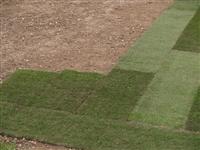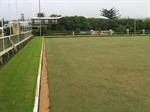 Repairing/Renovating A Lawn
Repairing/Renovating A Lawn
All sorts of things can go wrong with lawns, causing patches of grass to die, or simply to lose their vigor. Often the best treatment is to dig out that section of the lawn and replace it as you would do when planting a new lawn. Any soil and unhealthy grass which is removed should be thrown away. If it is diseased, take it to the tip or burn it. For areas that are not severely damaged, aeration, fertilisation and correct watering and mowing will soon encourage a healthy lawn to grow.
LAWN AERATION
Aeration involves punching holes into a lawn to improve drainage, water penetration and root growth. In some cases aeration is also done to reduce thatch build up.
Lawns on heavy soils or which suffer a lot of use need aerating regularly if the grass is to remain healthy.
Aeration Equipment
Aeration can be carried out manually (using a fork), or with a special aerating machine.
Coring
Coring is one of the best ways to aerate. This involves removal of cores of soil using a hollow tine (ie. metal tube) which plunges into the soil and extracts or core. This method leaves a clean hole in the turf without causing any further compaction at all. Coring equipment can be as simple as a hollow tine fork (available from specialist garden shops) which is used manually in small areas; or as complex as self propelled mechanical units.
After coring a turf, you will be left with cores of soil laying on the surface. These must be swept or raked and removed from the lawn. Often a light topdressing is applied 7 to 14 days after coring of a lawn. This will fill depressions left by the operation and help maintain levels.
 Spiking
Spiking
Spiking doesn't work as well as coring, but anyone can "spike" a lawn using just a common garden fork.
This involves penetrating the soil with solid spikes(or tines). Unlike coring, soil is not removed. A hole is made by simply pushing soil to the side as the spike penetrates. This method will create a compacted zone of soil around the edge of the hole it creates. As such spiking is nowhere near as effective a form of aeration as what coring is. If the soil suffers too much compaction prior to spiking, this treatment might create holes which have an even more compact, impermeable layer on their sides.
Spiking may be of advantage in breaking the surface to allow penetration of water & fertilizer (if there is an impermeable surface layer such as dry algae). Generally spiking is only considered a temporary, short term answer to aeration problems.
ROLLING LAWNS
Rolling is a technique used for flattening/levelling a lawn surface. It is particularly important on greens & other sporting surfaces where a perfectly level surface is very important. Frequent rolling will cause compaction though and unless aeration is also frequently used, it is not advisable.
TOPDRESSING
Topdressing involves spreading a thin layer of specially selected soil over the top of existing turf. This might be done for any one of the following reasons:
- Thatch control...the thatch is a tightly intermingled layer of dead vegetation and turf plants at soil level. As time goes on, leaves and roots die & are replaced by new growth. Through this happening, thatch is continually increasing. Topdressing places a layer of fresh soil on the surface which is free of thatch.
-
Levelling...Regular topdressing helps maintain an even surface to a lawn. Unless this or some other operation is carried out, a turf will become uneven (eg: When someone stands on a wet lawn they leave a depression/ when an insect burrows under the grass & it's tunnel collapses).
-
Revitalizing...By adding fresh soil to a turf soil structure may be improved (ie: If sand is topdressed onto a clay soil); new nutrients are made available by the fresh soil etc.
-
Winter Protection...In areas of extreme cold, a topdressing in late autumn can give winter protection to warm season grasses such as couch.
-
Covering a sowing of seed, stolons or rhizomes New nutrients are made available by the fresh soil etc.
 WATERING
WATERING
Lawns need a lot of water during the drier months in order to maintain even growth. Water should to be applied to the lawn in an even distribution pattern, so that no 'dry' patches are created. A purpose built irrigation scheme incorporated into the lawn will achieve the best results. Systems need not be complicated in design, and local hardwear stores will usually have off the shelf kits available, as well as a good supply of extra fittings etc. to help you build the perfect system for your garden. Systems can either be incorporated into the lawn whilst it is under construction, or alternatively can be installed after the lawn is constructed.
Pulsed watering
On heavy soils, watering every day often keeps the surface of the soil wet, while the lower soil remains dry. If this happens, the roots of both grass and garden plants will tend to come to the surface. Pulsed watering is a way of getting the water to penetrate deeper, and by keepin a reservoir of moist soil deeper down, less watering becomes necessary. Simply pulsed watering involves putting the sprinkler on for a short period, turning it off for 5-15 minutes to allow the water to soak in, then putting it on again for another short period. Repeating this procedure several times once every 3-4 days in even the hottest weather will use less water and result in a healthier lawn than watering heavily every day.
MOWING
Lawns are frequently cut too low for their own health in Australia. Some turf varieties will tolerate lower cutting than others, though for most, the ideal height is at least 2cm tall.
Best Height to cut different lawns:
- Bentgrass: 0.5cm (on a bowling or golf green)
- Bentgrass: 1 - 2cm (in a garden lawn)
- Kentucky Bluegrass: 3.5cm
- Creeping Fescue: 3.5cm
- Tall Fescue: 6cm
- Perennial Ryegrass: 3cm
- Bermuda couch grass: 2cm
- Buffalo Grass: 3cm
- Kikuyu: 2cm
If you mow too close, you will scalp the grass in places (ie. shear it off at ground level or lower). This is a particular problem if the lawn surface is uneven or bumpy, if you don't mow often enough, or if the thatch is thick and spongy (so the mower sinks into the thatch). Scalped turf looks ugly and can die allowing weeds to invade.
The frequency of mowing depends on the time of year (rate of growth), the height of cut and the quality of lawn you seek. If you want the best quality lawn, you must mow more often. The pattern of mowing will affect the way the turf plants grow. If you mow in the same direction every time, the grass will tend to lie over and grow in the direction which you mow. This gives an affect which might not be overly obvious, but it can affect the way a golf ball rolls, or the subtle appearance of a turf. Alternating the direction of mowing, or cutting the grass higher will eliminate this affect.
Grass Clippings can be left lying on the lawn if you mow often enough, but not if they are so bulky that they lie in lumps on the surface and smother patches of grass. If your clippings are to be collected and used in compost or as a mulch on garden beds, be sure that they don't contain any weed seeds. Couch grass lawns can produce viable seed heads within a week of mowing in warm weather.
MOWERS
There are two main types of mowers used in Australian home gardens. The reel or cylinder mower cuts grass clean like a pair of scissors, hitting the grass at an angle and wedging it against a metal plate. The rotary mower cuts the grass by hitting it at a 90 degree angle with a sharp blade mounted on a rotating horizontal plate. If the blades are kept very sharp, and the grass is not too soft, this cut can also be sharp, but otherwise, a rotary mower can tear grass leaving a jagged edge which can cause the grass to brown off a little. This is not as healthy for the grass, and often leads to rotary mown lawns loosing their lush look within a few days of being cut.
Study Turf Care
More from ACS
Ebook - Growing and using grasses and grass like plants: identify, cultivate illustrated encyclopedia
View eBook
Ebook - Identify, select, grow, care, propagate, landscape,
dictionary of perennials.
View eBook
Ebook - Know what you can grow where and how with this accessible text.
View eBook
Course - Informative and comprehensive course suited to professionals and garden ethusiasts alike.
View Course